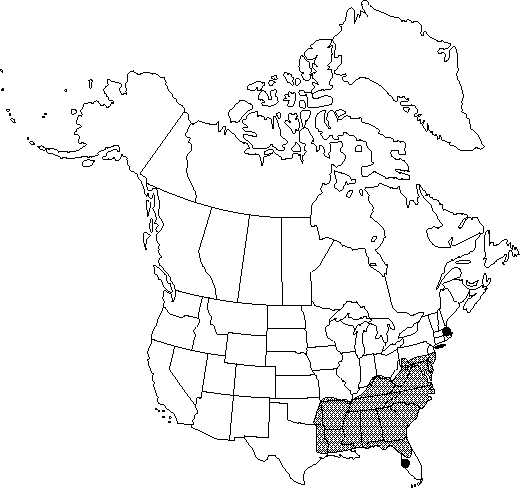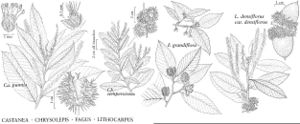Difference between revisions of "Castanea pumila"
Gard. Dict. ed. 8, Castanea no. 2. 1768.
FNA>Volume Importer |
FNA>Volume Importer |
||
| Line 13: | Line 13: | ||
}}{{Treatment/ID/Special_status | }}{{Treatment/ID/Special_status | ||
|code=F | |code=F | ||
| − | |label= | + | |label=Illustrated |
}} | }} | ||
|basionyms= | |basionyms= | ||
| Line 19: | Line 19: | ||
|name=Castanea alnifolia | |name=Castanea alnifolia | ||
|authority=Nuttall | |authority=Nuttall | ||
| + | |rank=species | ||
}} {{Treatment/ID/Synonym | }} {{Treatment/ID/Synonym | ||
|name=Castanea alnifolia var. floridana | |name=Castanea alnifolia var. floridana | ||
|authority=Sargent | |authority=Sargent | ||
| + | |rank=variety | ||
}} {{Treatment/ID/Synonym | }} {{Treatment/ID/Synonym | ||
|name=Castanea floridana | |name=Castanea floridana | ||
| − | |authority= | + | |authority= |
| + | |rank=species | ||
}} {{Treatment/ID/Synonym | }} {{Treatment/ID/Synonym | ||
|name=Castanea pumila var. ashei | |name=Castanea pumila var. ashei | ||
|authority=Sudworth | |authority=Sudworth | ||
| + | |rank=variety | ||
}} | }} | ||
|hierarchy=Fagaceae;Castanea;Castanea pumila | |hierarchy=Fagaceae;Castanea;Castanea pumila | ||
| Line 54: | Line 58: | ||
-->{{#Taxon: | -->{{#Taxon: | ||
name=Castanea pumila | name=Castanea pumila | ||
| − | |||
|authority=(Linnaeus) Miller | |authority=(Linnaeus) Miller | ||
|rank=species | |rank=species | ||
| Line 68: | Line 71: | ||
|publication title=Gard. Dict. ed. | |publication title=Gard. Dict. ed. | ||
|publication year=1768 | |publication year=1768 | ||
| − | |special status=Endemic; | + | |special status=Endemic;Illustrated |
| − | |source xml=https://jpend@bitbucket.org/aafc-mbb/fna-data-curation.git/src/ | + | |source xml=https://jpend@bitbucket.org/aafc-mbb/fna-data-curation.git/src/f50eec43f223ca0e34566be0b046453a0960e173/coarse_grained_fna_xml/V3/V3_746.xml |
|genus=Castanea | |genus=Castanea | ||
|species=Castanea pumila | |species=Castanea pumila | ||
Revision as of 21:30, 16 December 2019
Shrubs or trees, to 15 m, often rhizomatous. Bark gray to brown, smooth to slightly fissured. Twigs puberulent with spreading hairs, occasionally glabrate with age. Leaves: petiole 3-7(-10) mm. Leaf blade narrowly elliptic to narrowly obovate or oblanceolate, 40-210 × 20-80 mm, base rounded to cordate, margins obscurely to sharply serrate, each abruptly acuminate tooth with awn usually less than 2 mm; surfaces abaxially typically densely covered with appressed stellate or erect-woolly, whitish to brown trichomes, sometimes essentially glabrate especially on shade leaves, veins often minutely puberulent. Pistillate flower 1 per cupule. Fruits: cupule 2-valved, enclosing 1 flower, valves irregularly dehiscing along 2 sutures, longest spines usually less than 10 mm; nut 1 per cupule, ovate-conic, 7-21 × 7-19 mm, round in cross section, not flattened, beak less than 3mm excluding styles.
Phenology: Flowering spring (May–Jun).
Habitat: Forest, open woods, forest understory, dry sandy and wet sandy barrens
Elevation: 0-1000 m
Distribution

Ala., Ark., Del., Fla., Ga., Ind., Ky., La., Md., Mass., Miss., Mo., N.J., N.Y., N.C., Ohio, Okla., Pa., S.C., Tenn., Tex., Va., W.Va.
Discussion
Castanea pumila was thought to be extirpated from Long Island, New York, but it was recently recollected in Suffolk County.
Numerous names have been applied to populations included here under Castanea pumila (see also C. ozarkensis). In general, the pattern of morphologic variation suggests three forms that have some geographic and ecologic continuity, but among which sufficient clinal variation occurs to prevent easy recognition. Plants of higher elevation and northern populations tend to be trees or large shrubs with densely tomentose vestiture of the abaxial leaf surface, while southern coastal populations typically have flat-stellate vestiture, often very sparse or even glabrate (e.g., C. floridana). These coastal populations may be separated into forms that are trees or large shrubs with leaves sparsely to not at all glandular versus low rhizomatous shrubs with prominent globose glands on twigs and leaves (centered in northern Florida and adjacent Georgia). The latter form is probably the same as C. alnifolia.
Various preparations of the leaves of Castanea alnifolia were used by Native Americans medicinally to relieve headaches and as a wash for chills and cold sweats; preparations from unspecified parts of the plants were used to treat fever blisters (D. E. Moerman 1986).
Selected References
None.
